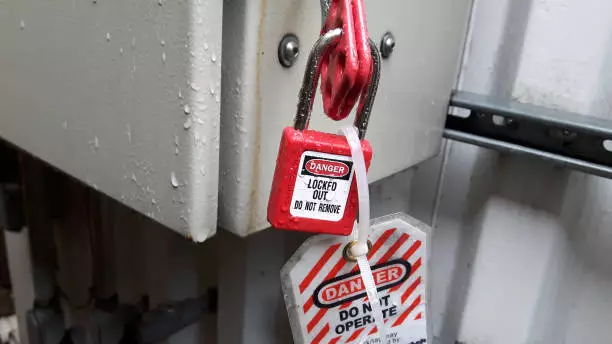Every workplace situation that involves equipment that may lead to the accidental release of harmful energy needs to be handled with lockout tagout procedures. In this case, “hazardous energy” includes not just electricity but also various forms of energy, such as hydraulic pressure, pneumatic pressure gas, and hydraulic pressure. LOTO methods aim to protect against the direct exposure to this energy and avoid harm from any equipment or object that could be moved by this energy (e.g., the pneumatic press accidentally activating).
LOTO procedures should be established on a workplace-wide basis, which means that all employees are required to be trained to use the identical procedure. The procedures typically include the use of tags and locks; however, when it’s not possible to add locks to a system, tags can be utilized solely.
The purpose of locks is to stop workers from using the equipment or accessing specific parts or parts of equipment. However, tags are employed as a method of cautioning against activating or making use of a particular piece of equipment.
Here are some essential aspects of the LOTO procedure.
Program and Policy
The first step in achieving lockout/tagout success is to create and document the energy control program or policy for your equipment. A written lockout policy constitutes the basis of your overall lockout strategy. It is essentially a blueprint for establishing and explaining the key elements of your lockout program.
It is essential to be aware of OSHA’s guidelines and special requirements for your employees to ensure they know and can implement the guidelines in their job. The program should not be only a temporary fix. It must be reviewed annually on a basis to ensure it’s still in place and safeguards employees. Creating a lockout tagout safety plan must be a joint effort by every level of the business.
Machine-Specific Procedures
The lockout procedure should identify the equipment being used and provide the steps required to close down the equipment, isolate it, block it, and secure the equipment. The procedure should also contain the steps needed to replace, remove and move lockout tagout devices.
Beyond compliance requirements, it is recommended to develop best practices with specific images of machines to identify the energy isolation points. They should be placed near where the machine is used to ensure that employees are given clearly written, easily understood instructions.
Additionally, make sure the procedures you use are specific to the workforce you have to enhance employees’ understanding. For instance, you must publish multi-lingual policies if you have a multi-lingual workforce.
Identifying and Marking Energy Isolation Points
Locate every energy control point, including switches, valves breakers, and plugs with permanent and uniform Labels or Tags. These points should be identified. Also, keep the fact that these labels and tags must be in line with the specific equipment methods from the second step.
Training and Audits
Training for employees and regular program inspections will ensure that the lockout process is running without a hitch.
Training should cover OSHA standards and your own program’s specific requirements and procedures specific to your machine. Employees must be trained in accordance with the following three categories:
- Employees who are authorized can lockout equipment and machinery to perform maintenance
- The employees affected don’t meet lockout requirements; however, they use the equipment which is receiving maintenance
- However, other employees that do not employ the machinery are present in the space in which the piece of equipment receives maintenance.
Proper Lockout Tagout Devices
The next aspect of your lockout plan is providing employees with the required devices to ensure they are secure. There are various products available out there, and deciding on the best solution for your needs is crucial to the effectiveness of your lockout. It is vital to keep a record of your lockouts and choose devices that meet the requirements of every lockout location.
When you lock out an item of equipment, you must adhere to these seven steps to ensure you’re secure and compliant:
- Inform employees affected of your intention to lock out the equipment
- Examine the written lockout procedure
- Use the routine machine stop
- Turn off all isolation devices for energy.
- Eliminate your energy isolation settings
- Eliminate any stored or remaining energy
- Check the zero-energy state before you start servicing safely
Sustainability
Last but not least, it is recommended to take a continual enhancement approach for your lockout policy. By constantly reviewing your plan, you’re creating a safe and proactive environment that deals with lockouts tagouts. This lets your business concentrate on maintaining an elite program rather than starting from scratch every year and only reacting when there is a problem.
Are you unsure if you can sustain the costs of sustainability? Think about the cost of creating your lockout tagout system every year. You can keep your program year-round to increase your safety culture and reduce the costs of re-inventing the wheel. When you view your program in this way, it’s evident that a sustainable program helps to keep one step ahead of the competition while also saving time and money Stolenmaker Geel.
Final Words
It’s important to stay secure when working with large machines. Implementing a robust lockout plan is an excellent way to make sure that everyone who works with the equipment is safe from injury.
